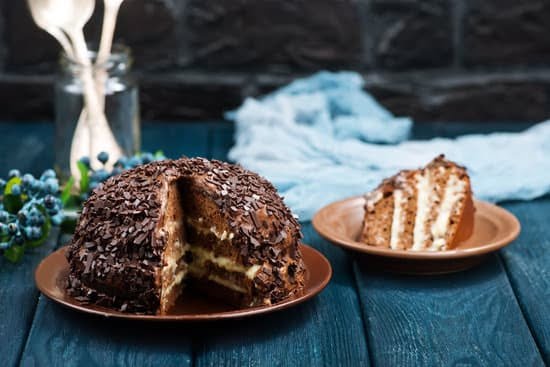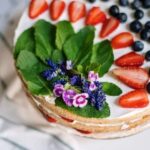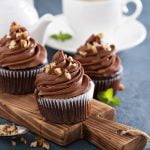Are you looking for a unique and stunning way to decorate your cake? In this article, we will explore how to decorate cake with artificial flowers, a rising trend in the world of cake decoration.
The use of artificial flowers offers several benefits over real flowers, including longer-lasting beauty, versatility, and the ability to create custom color schemes. Whether you’re a professional baker or an aspiring home decorator, learning how to effectively use artificial flowers for cake decoration can take your creations to the next level.
With the increasing popularity of artificial flowers for cake decoration, it’s important to understand how to choose the right ones. From selecting the perfect color and size to considering different materials, we’ll provide tips on finding the best artificial flowers to complement your cake design. Additionally, we’ll discuss the importance of adding greenery and fillers to enhance the overall floral decoration and create a more natural look.
Baking and preparing your cake for decoration is just as crucial as choosing the right artificial flowers. We’ll guide you through a step-by-step process that includes using frosting and fondant for a flawless canvas. Plus, we’ll provide detailed instructions on arranging the artificial flowers on your cake using various techniques such as cascading, clustered, or scattered arrangements. Let’s dive into the art of using artificial flowers to elevate your cake decorating skills.
Choosing the Right Artificial Flowers
When it comes to selecting the right artificial flowers for cake decoration, there are a few key factors to consider in order to achieve the desired look and ensure that the flowers are safe for use on food. Here are some tips for choosing the best artificial flowers for cake decoration:
1. Color: The color of the artificial flowers should complement the overall color scheme and theme of the cake. It’s important to select flowers that will enhance the aesthetic appeal of the cake without clashing with other decorative elements. Consider using a mix of complementary colors or sticking to a single color for a more cohesive look.
2. Size: The size of the flowers should be proportionate to the size of the cake. Large flowers may overwhelm a small cake, while tiny flowers may get lost on a larger cake. It’s essential to choose artificial flowers that are visually balanced with the size of the confection they will adorn.
3. Material: When selecting artificial flowers for cake decoration, it’s crucial to choose materials that are food-safe. Ensure that the stems and petals of the flowers are made from non-toxic materials that are suitable for contact with edible items. Silk, gum paste, or fondant flowers are popular choices for their food-safe properties and realistic appearance.
Remember, when incorporating artificial flowers into your cake design, it’s important to thoroughly clean and sanitize them before use to remove any dust or particles that may have accumulated during storage.
Ultimately, by considering these factors-color, size, and material-you can ensure you’re choosing the best artificial flowers for your cake decoration needs while also maintaining food safety standards.
– Choose silk options when considering flower types.
Preparing the Cake
The first step in preparing a cake for decoration is to bake it to perfection. This involves following a tried-and-true cake recipe, ensuring that the batter is mixed thoroughly, and then baking it at the right temperature for the appropriate amount of time. Once the cake is baked, it should be left to cool completely before any decorating begins.
After allowing the cake to cool, it’s time to prepare it for decorating by applying a layer of frosting. This not only adds flavor but also serves as an adhesive for the fondant and decorations. The type of frosting used can vary depending on personal preference and the specific design requirements of the cake.
Once the frosting has been applied, fondant can be added to create a smooth and polished surface for decorating. Rolled fondant is often used to cover cakes due to its pliability and versatility in creating clean lines and intricate designs. After rolling out the fondant into a thin sheet, it should be carefully draped over the cake and smoothed out to remove any air bubbles or wrinkles.
Overall, taking these steps will ensure that your artificial flower decorations have a beautiful canvas to shine on. Without proper preparation and baking techniques, even stunning floral arrangements can fall flat on a poorly executed cake base.
| Key Ingredient | Best Option |
|---|---|
| Frosting | Buttercream frosting |
| Type of Fondant | Rolled fondant |
Creating a Floral Arrangement
Creating a beautiful and visually stunning floral arrangement on a cake with artificial flowers can be a wonderful way to add a touch of elegance and sophistication to any special occasion. Whether it’s for a wedding, birthday, or other celebration, the use of artificial flowers offers endless possibilities for creating unique and eye-catching designs.
In this section, we will provide detailed instructions on how to arrange the artificial flowers on the cake using different techniques such as cascading, clustered, or scattered arrangements.
When creating a cascading floral arrangement on a cake, it’s important to start by selecting artificial flowers that have a natural flow and drape. Cascading arrangements typically involve arranging the flowers in a way that creates an elegant downward flow from the top of the cake to the base. This technique works well for taller cakes and adds a sense of drama and beauty to the overall design.
For clustered arrangements, the focus is on grouping artificial flowers together in tight bunches to create focal points on the cake. This technique allows for more concentration of color and texture in specific areas of the design, providing visual interest and depth. When arranging clustered artificial flowers, it’s essential to consider balance and proportion to ensure that the overall look is harmonious and pleasing to the eye.
On the other hand, scattered arrangements involve placing artificial flowers in a random yet intentional manner around the cake. This technique creates a whimsical and organic feel, perfect for adding a touch of romance and charm to the overall design. Scattered arrangements also allow for creative freedom in mixing different flower varieties and colors for a more eclectic and natural effect.
No matter which technique you choose, it’s essential to carefully place each artificial flower on the cake with precision and gentle handling to avoid damaging both the flowers and the cake itself. Additionally, experimenting with different combinations of techniques can result in truly unique floral arrangements that are sure to impress any event guests. Now let’s explore how these techniques can be put into practice when decorating cakes with artificial flowers.
Securing the Flowers
When it comes to decorating a cake with artificial flowers, one of the most crucial steps is securely attaching the flowers to the cake. This not only ensures that the flowers stay in place throughout the event but also prevents them from causing any damage to the cake. There are several techniques and tips for effectively securing artificial flowers to a cake, and here’s how to do it:
Using Flower Picks or Food-Safe Stems
One of the most common methods for securing artificial flowers on a cake is by using flower picks or food-safe stems. These handy tools allow you to insert the stems of the artificial flowers directly into the cake without compromising its integrity. When selecting flower picks or stems, make sure they are food-safe and clean them thoroughly before use.
Applying Edible Glue
Another effective way to secure artificial flowers to a cake is by using edible glue. This special adhesive is safe for consumption and can be applied to the base of each flower before carefully placing it on the desired spot on the cake. It’s important to use edible glue sparingly and strategically to avoid any excess seeping out from under the flower.
Creating a Floral Topper
For larger floral arrangements or cascading designs, creating a floral topper can be an excellent way to secure artificial flowers onto a cake. By arranging and securing a cluster of artificial flowers onto a separate base (such as foam or cardboard) with toothpicks or wire, you can then gently place this floral topper onto the cake without directly piercing its surface.
By following these secure attachment methods, you can successfully decorate your cakes with beautiful artificial flowers without worrying about them falling off or damaging your creation.
Adding Greenery and Fillers
When it comes to decorating a cake with artificial flowers, it’s essential to consider the overall floral arrangement. While the flowers are undoubtedly the stars of the show, adding greenery and fillers can significantly enhance the look and create a more natural and balanced design. Here’s how to incorporate greenery and fillers to take your cake decoration to the next level.
Choosing the Right Greenery and Fillers
The first step in adding greenery and fillers to your cake decoration is selecting the right elements. Consider using artificial leaves, vines, or small sprigs of foliage that complement the color and style of your chosen flowers. Opt for materials that are easy to work with and can be shaped or trimmed as needed to create the desired effect.
Placing Greenery and Fillers
Once you have selected the appropriate greenery and fillers, it’s time to strategically place them around the floral arrangement on the cake. Start by tucking small pieces of greenery under and around the flower blooms to add depth and texture. Avoid overcrowding the arrangement, but ensure that there is a good balance of flowers, greenery, and fillers throughout.
Creating a Natural Look
The goal of adding greenery and fillers is to create a more natural look for your floral cake decoration. By carefully placing these elements, you can achieve a harmonious balance between all components, making the design feel cohesive and organic. Take inspiration from real garden arrangements when deciding on placement and consider varying heights and textures for added visual interest.
By incorporating greenery and fillers into your cake decoration with artificial flowers, you can elevate the overall design while achieving a more natural and balanced look. The key is to choose complementary elements, strategically place them within the floral arrangement, and aim for a cohesive design inspired by nature. With these tips in mind, you can create stunning floral cakes that are sure to impress at any special occasion.
Additional Decorative Elements
When it comes to decorating a cake with artificial flowers, the addition of other decorative elements can truly enhance the overall aesthetic and create a stunning focal point. In addition to artificial flowers, incorporating edible pearls, edible glitter, or decorative ribbons can elevate the design and add a touch of elegance to the cake. Here are some suggestions for using these elements to complement the floral arrangement:
- Edible Pearls: Edible pearls are a wonderful way to add a touch of sophistication and glamour to a cake decorated with artificial flowers. They can be strategically placed within the floral arrangement to mimic dew drops or used as accents around the base of the cake for an extra pop of texture and shine.
- Edible Glitter: Edible glitter is another versatile decorative element that can be used to enhance the overall look of a floral cake design. Whether in silver, gold, or iridescent shades, it can be lightly dusted over the petals of the artificial flowers or used sparingly for a subtle shimmer effect.
- Decorative Ribbons: Adding decorative ribbons is a classic way to tie together the theme of the cake with artificial flowers. From satin ribbons in coordinating colors to delicate lace ribbons for a romantic touch, they can be wrapped around the tiers of the cake or tied into bows as an elegant finishing touch.
By incorporating these additional decorative elements alongside artificial flowers, bakers have endless opportunities to get creative and personalize their cake designs. Whether aiming for a simple and understated look or a more elaborate and luxurious feel, choosing complementary elements that seamlessly integrate with the floral arrangement will result in a visually stunning masterpiece.
Remember that balance is key – less is often more when it comes to adding these elements, so exercise restraint for an elegant yet impactful finish on your decorated cake.
Overall, combining artificial flowers with other decorative elements offers endless possibilities for creating unique and visually striking cakes that are guaranteed to leave a lasting impression at any event. So go ahead and experiment with different combinations and let your creativity flow as you bring your vision for a beautifully adorned cake to life.
Storage and Preservation
As you’ve learned how to decorate a cake with artificial flowers, it’s important to know how to properly store the decorated cake to maintain its freshness and appearance until the event. Here are some essential tips for storing and preserving a cake adorned with artificial flowers.
First, it’s crucial to choose a suitable storage container for the decorated cake. Opt for a cake box that is spacious enough to accommodate the size of the cake without squishing any of the floral decorations. Make sure that the lid of the container does not come into direct contact with the flowers or other decorative elements on top of the cake.
Once you have selected an appropriate storage container, carefully place the decorated cake inside, ensuring that it sits flat and does not shift during transportation. If you have opted for a tiered cake, consider using dowels to provide support between each layer and prevent them from sliding or collapsing during storage.
It’s also important to consider temperature and humidity when storing a decorated cake with artificial flowers. Ideally, cakes should be kept in a cool, dry place away from direct sunlight, as heat can cause the artificial flowers to wilt or lose their color. Additionally, high humidity can cause condensation to form on the surface of the cake, potentially damaging the decorations.
To further protect the decorated cake during storage, you may want to refrigerate it if it contains perishable fillings or frosting. However, be cautious when refrigerating an adorned cake, as sudden temperature changes can affect the appearance of artificial flowers and other decorative elements. To ensure that your decorated cake remains in pristine condition until the event, follow these guidelines for proper storage and preservation.
| Storage Tips | Preservation Guidelines |
|---|---|
| Choose spacious container | Avoid direct sunlight |
| Use support for tiered cakes | Avoid high humidity |
| Refrigerate if necessary | Avoid sudden temperature changes |
Conclusion
In conclusion, using artificial flowers for cake decoration offers a multitude of benefits, including the ability to achieve a stunning floral look without the risk of harmful toxins or wilting that can come with real flowers. By following the tips outlined in this article, readers can confidently select the right flower-cake/932443417473/” target=”_blank” rel=”follow noopener”>artificial flowers, prepare and secure them on their cakes, and elevate their designs with additional decorative elements.
The step-by-step guide provided ensures that anyone can create a beautiful floral arrangement on their cakes, regardless of prior experience.
It’s important to remember that choosing high-quality artificial flowers is essential for achieving a realistic and elegant look. Opt for silk or foam-based flowers in colors and sizes that complement the overall cake design. Additionally, considering adding greenery and fillers to enhance the floral arrangement and create a more natural appearance.
To truly make your cake stand out, feel free to get creative with your designs by experimenting with different arrangements, techniques, and decorative elements. Whether you’re aiming for a sophisticated cascading arrangement or a whimsical scattered placement, there are endless possibilities on how to decorate cake with artificial flowers. With proper preparation and attention to detail, your decorated cake is sure to be a show-stopper at any event.
Frequently Asked Questions
How Do You Attach Fake Flowers to a Cake?
Attaching fake flowers to a cake can be done by inserting the stems into food-safe floral picks or straws before placing them into the cake. Another option is to place the flowers on a separate food-safe base and then position it on the cake.
Is It Safe to Decorate a Cake With Artificial Flowers?
It is generally safe to decorate a cake with artificial flowers as long as they are labeled as food-safe and specifically made for use in cakes or other edible creations. Non-edible flowers or decorations should not come into direct contact with the cake.
How Do You Clean Fake Flowers for a Cake?
Cleaning fake flowers for a cake can be done by gently wiping them with a damp cloth or sponge. Care should be taken to not use any harsh chemicals or excessive water that could affect the color or integrity of the flowers. If possible, check the manufacturer’s instructions for best cleaning practices.

Welcome to our cake decorating blog! My name is Destiny Flores, and I am the proud owner of a cake decorating business named Cake Karma. Our mission is to provide delicious, beautiful cakes for all occasions. We specialize in creating custom cakes that are tailored specifically to each customer’s individual needs and tastes.





